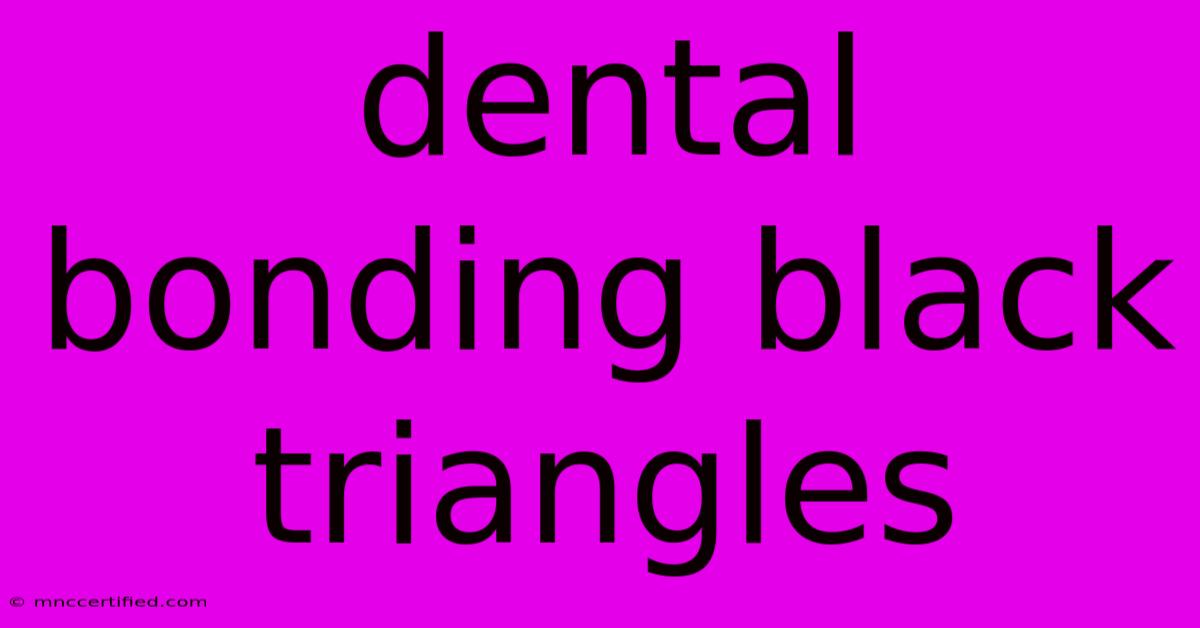Dental Bonding Black Triangles

Table of Contents
Dental Bonding: A Solution for Black Triangles Between Teeth?
Black triangles, those unsightly gaps that appear between your teeth, can significantly impact your confidence and smile aesthetics. While often associated with gum recession, they can also be a result of tooth shape and size. Fortunately, dental bonding offers a viable solution for many patients looking to improve the appearance of these spaces. This comprehensive guide explores dental bonding as a treatment for black triangles, addressing its effectiveness, procedure, cost, and potential drawbacks.
Understanding Black Triangles
Before diving into the solution, it's crucial to understand the problem. Black triangles, also known as gingival embrasures, are the dark spaces that can form between teeth, exposing the gum line. Several factors contribute to their formation, including:
- Gum recession: This is a common cause, as the gum tissue pulls back, exposing more of the tooth and creating a visible gap.
- Tooth size and shape: Teeth that are naturally small or have uneven contours are more prone to black triangles.
- Aggressive brushing: Overly vigorous brushing can contribute to gum recession and, consequently, black triangles.
- Periodontal disease: Gum disease can lead to significant gum recession and the development of black triangles.
Dental Bonding: A Cosmetic Solution
Dental bonding is a minimally invasive cosmetic procedure that uses a tooth-colored resin material to fill in gaps and improve the overall appearance of your teeth. For black triangles, it's often a preferred solution because it's:
- Less invasive: Compared to other options like veneers or crowns, bonding requires less tooth preparation.
- Affordable: It's generally a more cost-effective option than other restorative procedures.
- Customizable: The resin can be precisely matched to the color of your natural teeth, resulting in a seamless and natural-looking result.
- Quick procedure: The procedure usually takes one or two appointments to complete.
The Dental Bonding Procedure for Black Triangles
The procedure typically involves the following steps:
- Examination and Consultation: Your dentist will assess the extent of the black triangles and discuss the suitability of bonding as a treatment option.
- Teeth Cleaning: Your teeth will be thoroughly cleaned to ensure proper bonding.
- Resin Application: The dentist applies a tooth-colored resin to the affected areas, carefully shaping and sculpting it to fill the black triangles and create a natural-looking contour.
- Curing: A special light is used to harden the resin, bonding it permanently to the tooth surface.
- Polishing and Finishing: The dentist polishes the bonded area to ensure a smooth, natural finish.
Longevity and Maintenance of Dental Bonding
While dental bonding can significantly improve the appearance of black triangles, it's essential to understand its limitations. The longevity of dental bonding depends on several factors, including:
- Location of the bonding: Bonding in areas that experience significant wear and tear may not last as long.
- Oral hygiene: Proper brushing and flossing are crucial to maintain the bonding and prevent staining.
- Diet: Avoiding staining substances like coffee, tea, and red wine can help prolong the life of the bonding.
Alternatives to Dental Bonding
Other options to consider for black triangles include:
- Gum grafting: This surgical procedure involves moving gum tissue from another area of the mouth to cover the exposed root surfaces.
- Porcelain veneers: These thin shells are bonded to the front surface of the teeth to improve their appearance, but they're more invasive and expensive than bonding.
- Crown lengthening: This surgical procedure reshapes the gum line to reduce the appearance of black triangles.
Cost and Insurance Coverage
The cost of dental bonding for black triangles varies depending on several factors, including the number of teeth treated, the location of the dental practice, and the dentist's fees. It's always advisable to discuss the cost and potential insurance coverage with your dentist before proceeding with the procedure.
Finding a Qualified Dentist
Finding a qualified and experienced cosmetic dentist is crucial for achieving optimal results. Look for dentists with a strong track record in cosmetic dentistry and a portfolio showcasing successful bonding procedures. Check online reviews and testimonials to gauge the experience of other patients.
In conclusion, dental bonding can be an effective and aesthetically pleasing solution for black triangles between teeth. While it's not suitable for all cases, its minimally invasive nature, affordability, and customizable results make it a popular choice for many patients seeking a confident and beautiful smile. Always consult with a qualified dentist to determine the best treatment plan for your individual needs and circumstances.

Thank you for visiting our website wich cover about Dental Bonding Black Triangles. We hope the information provided has been useful to you. Feel free to contact us if you have any questions or need further assistance. See you next time and dont miss to bookmark.
Featured Posts
-
Dan Hurley Free Throws Before U Conn Memphis Game
Nov 26, 2024
-
Adeles Last Vegas Residency Show
Nov 26, 2024
-
Glastonbury 2025 Lineup Rod Stewart
Nov 26, 2024
-
2001 Barry Bonds Baseball Card
Nov 26, 2024
-
Knicks Rout Nuggets Anunoby Scores 40
Nov 26, 2024